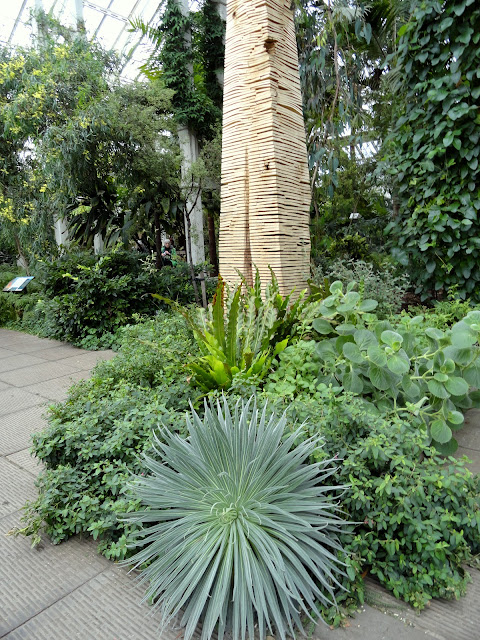Wednesday, October 17, 2012
Kew Wednesdays, visiting the Temperate House
We stepped out of the heat of the Palm House and right into a rain shower. Instead of taking the circuitous route to the Temperate House I had planned we headed straight there, seeking shelter. Exploring the Mediterranean Garden located between the two would have to wait until later.
Here we have arrived on the steps of the Temperate House, and are looking back towards the Mediterranean Garden...
My excitement at exploring another glass house was quickly crushed however when I discovered the door was locked and this hung in the window...
Thankfully that only applied to this segment of the house…
The next door I tried opened and we stepped into Tree Fern (Dicksonia Antarctica, from Australia) heaven!
“The Temperate House is the largest surviving Victorian glasshouse in the world, covering 5,850 square yards (4,880 square metres) and extending to 63 feet (19 metres) high. Kew director Sir William Hooker commissioned Decimus Burton to begin work on the glasshouse in 1859. With voracious Victorian collectors bringing back ever more species from around the globe, Kew needed somewhere to house its growing collection of semi-hardy and temperate plants. The Temperate House was officially opened, unfinished, in 1863. Because costs had soared during construction, it was not completed for another four decades.” (source)
I've also read that the sheer size of the Temperate House has made it home to many plants that have outgrown other parts of the Kew Gardens.
Adenanthos sericeus (aka Woolly Bush, a member of the Proteaceae family).
This shrub native to the south coast of Western Australia is taunting me, I love it. I've seen it for sale few places in my southern U.S. travels but since it’s not hardy for me I've resisted buying it (so far). I want to hug it.
More “rangy” Australian plant beauty…
Banksia serrata…
A lovely Echium wildpretii, with questionable piece of “art” behind it.
Xanthorrhoea australis (Grass tree), reminds me of the tall one I saw at the SF Botanical Garden/Strybing Arboretum.
How clever is this?
No sprinkler needed, just poke your water wand through a handle and placement is easy.
Scadoxus multiflorus, I believe…
I’ve been tempted by many an Erica, these are certainly fine…
If I got my labels correct I think the large-leafed plant winding around under the marvelous Restio is a Leucospermum grandiflorum. If I’m wrong then that label belongs to the soft green leaves in the lower left hand corner of this picture and the above.
And I think that’s a Leucadendron argenteum (Silver Tree) in the middle of this photo, although sadly it’s very hard to see.
No label on this bright happy Leucadendron either.
Someday I hope visit Kirstenbosch National Botanical Garden in South Africa to see all of the Proteas, until then a visit to University of California Santa Cruz Arboretum would do just fine.
Crocosmia
Aeonium undulatum
And now I know where capers come from! Capparis spinosa…
Unfortunately the staircase that leads to a viewing platform above was closed.
Finally, on my fourth day in London I saw my first Agave! Agave toneliana, hmm, never heard of it.
But it’s a beauty! And that’s a nice way to end our visit to the Temperate House.
Labels:
Kew Wednesdays,
London 2012
Subscribe to:
Post Comments (Atom)


















.JPG)

























No comments:
Post a Comment